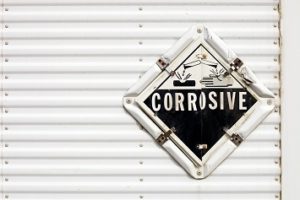If you offer or transport certain hazardous materials (hazmat), you may be required to develop and implement a Hazardous Materials Transportation Security Plan. Yesterday we discussed the conditions that would trigger the requirement to develop and implement a Security Plan and described one scenario where a Security Plan would be required unless the company took actions that would negate the requirement. Today we will look at two more scenarios questioning whether a Security Plan is required.
Scenario 2: Primary or Secondary Hazard
Should subsidiary hazards be considered when determining the applicability of the Security Plan requirements for shippers and carriers? Here’s the scenario.
A company ships a large bulk quantity of “UN2920, Corrosive liquid, flammable, n.o.s.,” with a primary hazard of Class 8, Packing Group II and a subsidiary hazard of Class 3, Packing Group III.
No. A Security Plan is not required in this scenario. Under the security plan regulations, a large bulk quantity is greater than 6,614 pounds (3,000 kilograms) for solids or 792 gallons (gal) (3,000 liters) for liquids and gases in a single packaging.
So, according to Pipeline and Hazardous Materials Safety Administration (PHMSA) guidance, for a large bulk quantity of “UN2920, Corrosive liquid, flammable, n.o.s., 8, 3, II,” with a primary hazard of Class 8, Packing Group II and a subsidiary hazard of Class 3, Packing Group III, a security plan would not be required, as there is no corresponding applicability in 49 CFR 172.800(b) for this material. Applicable Class 8 hazardous materials are large bulk quantities in Packing Group 1, while applicable Class 3 hazardous materials are large bulk quantities in Packing Groups I or II or Class 3 materials that require placarding.
In addition, unless specified in paragraph 49 CFR 172.800(b), the applicability for Security Plans refers to the primary hazard of a material or the definition of a hazard class.
Solution: Before you go to the expense and headache of developing and implementing a Security Plan with all its inherent expense and headache, make absolutely sure that you need one.
Scenario 3: A Tube Trailer
Is a tube trailer one bulk packaging that requires a Security Plan? Here’s the scenario.
A company has two tube trailer motor vehicles that each contain 54 Department of Transportation (DOT) specification cylinders that are permanently mounted lengthwise to a frame attached to the vehicle’s chassis. These cylinders have a capacity of 65 gal each; their own shutoff valve that is closed during transport. Each is connected with stainless steel tubing through a header, heat exchanger, and several additional valves to an automated valve that controls outlet pressure.
Yes. A Security Plan is required in this scenario. According to PHMSA guidance, the tube trailer is a bulk packaging because it is a transport vehicle, which (under 49 CFR 171.8) is defined as a cargo-carrying vehicle such as an automobile, van, tractor, truck, semitrailer, tank car or railcar used for the transportation of cargo by any mode. Each cargo-carrying body (trailer, railcar, etc.) is a separate transport vehicle. In addition, the tube trailer has a quantity of gas exceeding 792 gal, which meets the definition of a large bulk packaging that requires a Security Plan.
PHMSA guidance goes on to say that the tube trailer is also one packaging because its cylinders are coupled together through piping and a manifold. The presence of a shutoff valve and pressure relief device on each cylinder of a tube trailer do not alter the tube trailer’s designation as one packaging because:
- The cylinders can be filled with or release gas simultaneously; and
- A malfunctioning or inoperable valve and the resulting gas released could cause other valves in the packaging to malfunction or fail and, depending on the type of gas released, may cause the failure of the entire package.
Solution: Examine your hazmat transportation practices, policies and equipment. Determine if it is economically feasible to transport your hazmat in this manner. It may be that the development and implementation of a hazmat Security Plan is just part of the cost of doing business.

